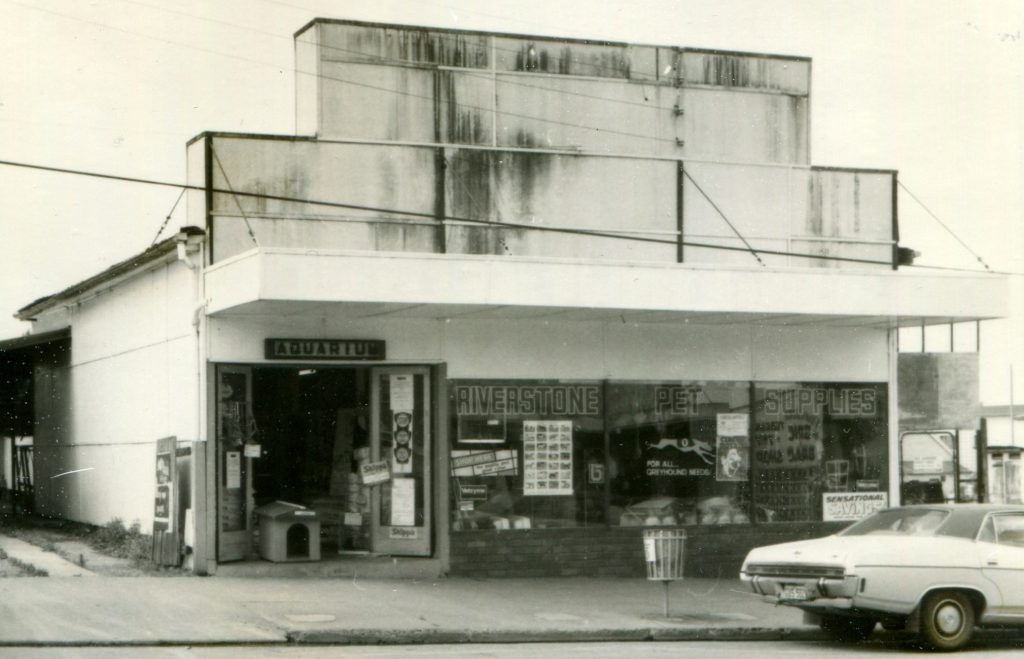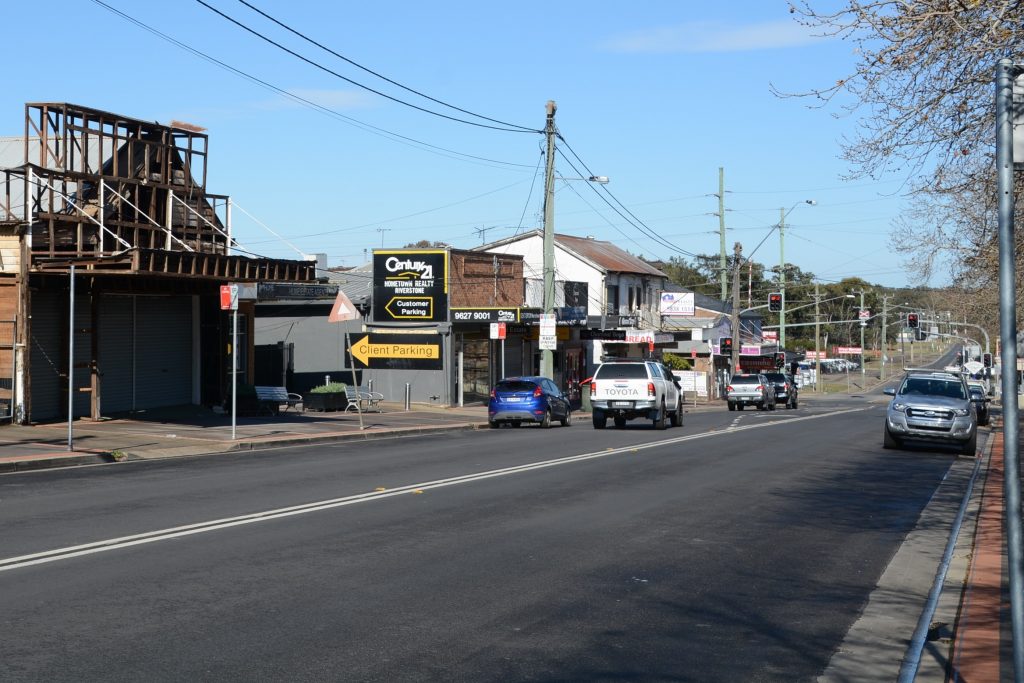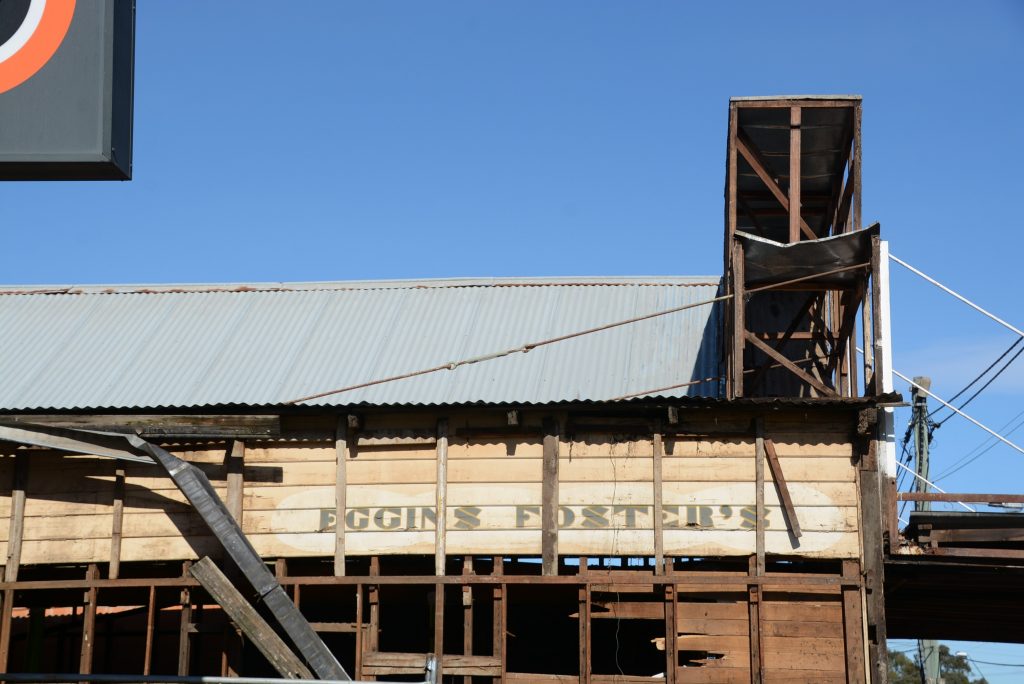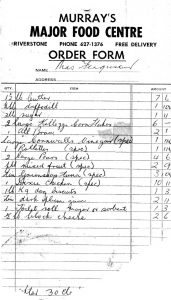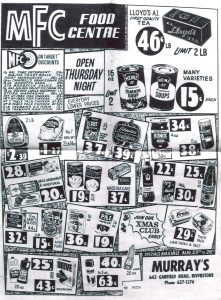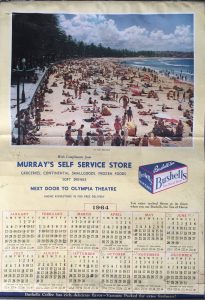by Alan Strachan
To the right of the BWS liquor shop on the southern side of Garfield Road East stood a building that has been empty for a number of years. The building was demolished in September this year. This article has been adapted from a full length article by Alan Strachan in 2008, in which he shared some memories of the shop in the time of Neil Murray.
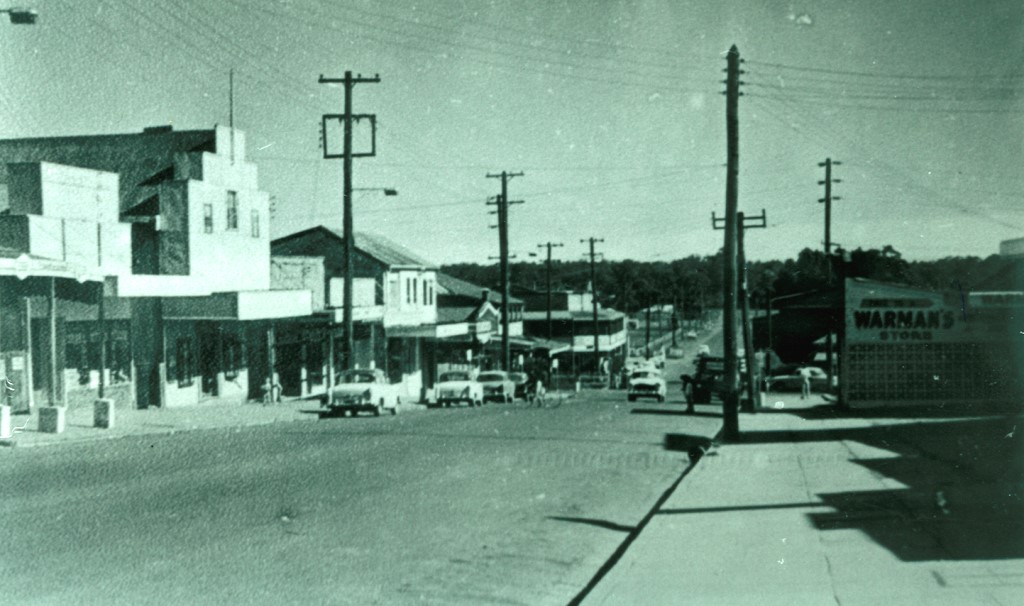
Photo: Verlie Sullivan
The grocery store, on the eastern side of the Olympia Picture Theatre, was operated and later owned by Neil Steward Murray and his mother, Amuri Stella Murray between 1957 and 1976.
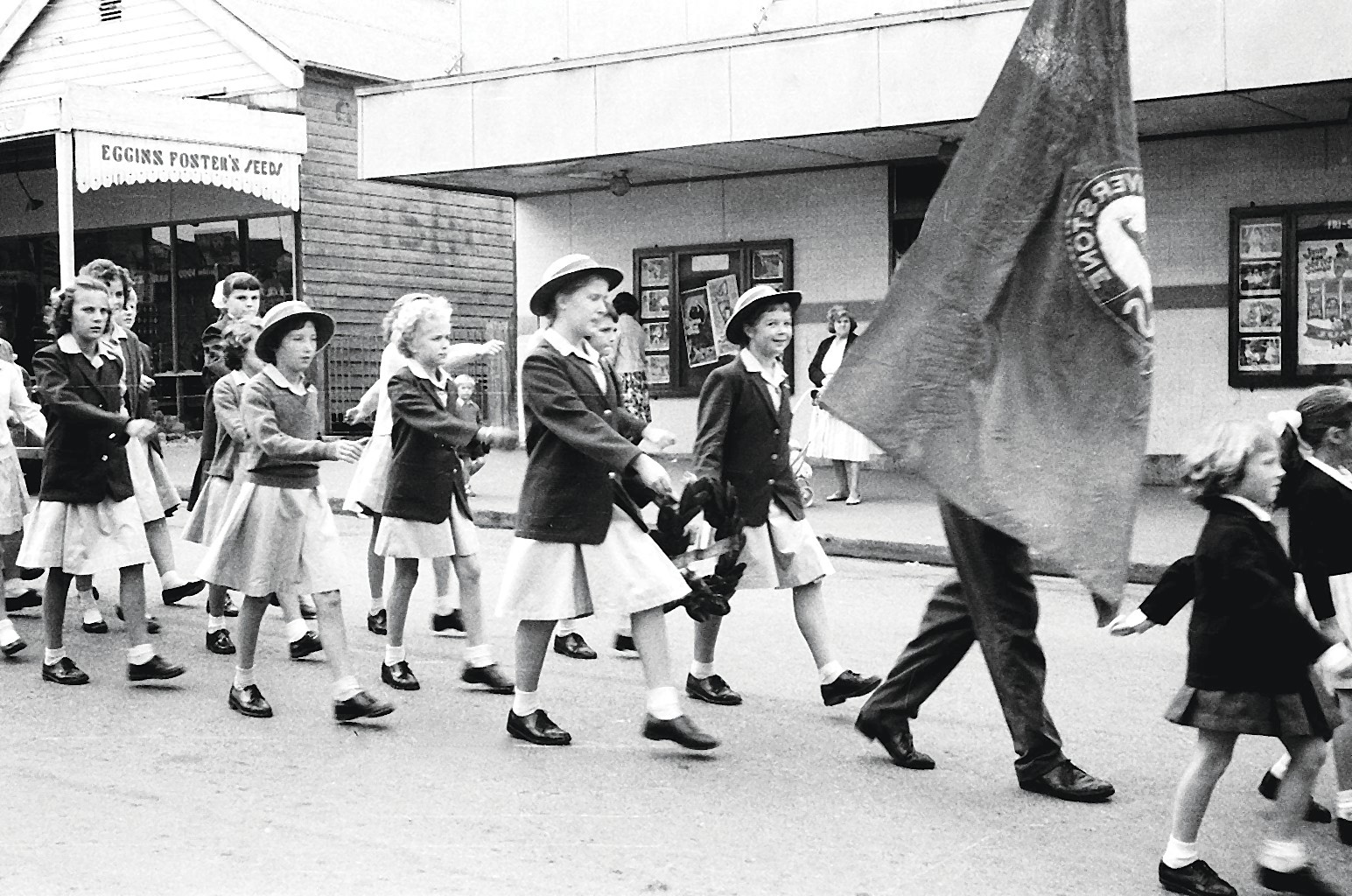
Photo: Maurie Haylor
I cannot establish when the shop and attached residence were built. In 1920 the shop was owned by Horace and Phillip Bambridge. After 30 years – they sold the store in 1949 to Carlisles Pty. Ltd.
In 1955 Carlisles sold the shop to Aldon Roy Cooke. Delma and Roy Cooke and their son Colin operated the store.
In March 1957, Raymond ‘Charlie’ Kennedy Murrell sold his Olympia Theatre to Neil Steward Murray and a syndicate. Neil was the Company Director of ‘Riverstone Olympia Pty. Ltd.’.
Neil Murray was born in Auckland, New Zealand on 9th April 1916, he was an only child. In the early 1920’s the Murrays moved to Guildford. When Neil left school he went to work with Harringtons Pty. Ltd. He enlisted in the Royal Australian Air Force [RAAF] during World War II where he was a LAC. He was a Chartered Accountant by trade and because of this he went in as a Pay Clerk. He went to America and came back as Corporal. He was discharged from the RAAF in 1946 and he and his mother operated a small grocery store at Yennora.
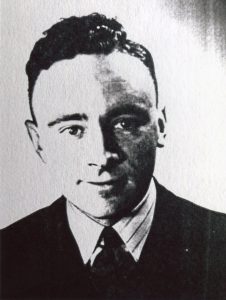
In 1957 Neil took over the lease of the shop from Mrs Delma Cooke, and took up residence at Riverstone. Neil considered that the shop and theatre went hand in hand, being next door to each other. It was convenient for him to live adjacent and run both businesses at the same time.
When Neil took over the shop, he had it converted into a self-serve grocery store. When their shop at Yennora was sold in 1958, Mrs Murray and Neil bought the store outright from Delma Cooke.
Under the ownership of the Murrays, new modern shelving and longer isles and freezers were added to make the store more customer friendly as a self-serve. The shop became known as “Murray’s” Store. Neil employed carpenter Bill Monk of Vineyard to build the new facade on the shop to match the Olympia Theatre next door. He also relocated the front door entrance to the shop to the eastern end of the building. The entrance consisted of two small plate glass wooden framed doors that opened outwards. Three large plate glass windows were installed at the front of the store.
Mrs Maisie [Bottle] Marlin recalls that she first worked at the Riverstone Meatworks before starting to work for Neil Murray at his shop in 1960. Maisie worked the cash register and stacked shelves.
In 1952, Ed Phillis, commenced working in the grocery known as Wood’s Shop where groceries and wine were sold. Ed made up orders and delivered groceries around Riverstone, Box Hill, Nelson, Marsden Park, Schofields, and Vineyard. He worked there for ten years and during this time earned a good reputation and rapport with the customers.
When he finished up at Wood’s shop, Neil Murray offered him a job. When Ed started working at Murray’s he recalls there were five staff. Neil Murray, Maisie Marlin, Matt Coyt. (whose main job was as projectionist in the theatre next door), Barry Edwards and Bill Monk. He also recalled that Mrs Murray was a kind old lady who sometimes came into the shop to help out.
Ed stacked shelves, made up grocery orders and delivered them in the blue Austin A40 utility van. Neil had put a canopy onto the back to protect the groceries from the heat and rain. As most of Ed’s old customers from Wood’s Shop had followed him, it built up the business. After working at Murray’s for four years, Ed decided to call it a day and finished up in early 1965.
Friday the 28th September, 1962 was a sad day for Neil and the staff, when Neil’s mother, Amuri Stella Murray passed away.
Robbery
Early Monday morning 23rd July 1962, thieves broke the glass doors of the shop and stole a considerable amount of tobacco and cigarettes. There were no more break and enters after that as Neil took on a young, male blue heeler cattle dog, that the previous owners could not control. Because he was savage, Neil named the dog Tiger. The dog was left to roam the yard of a night time. Upon hearing his savage bark and sighting Tiger no one entered the premises.
In 1964, like many other smaller family operated stores, Neil joined the Major Food Centre (MFC) grocery chain group, in an effort to build his business up and to compete with other local shops with cheaper grocery prices and weekly specials. At the time Murray’s had to compete with other self service stores like Warman’s Self Serve across the road, Granger’s Super Market in West Parade over the Railway Line near the Royal Hotel, and Dee-Jay’s/Foodland in Riverstone Parade. The cheaper prices were also to entice residents to shop locally without leaving the district to chase cheaper prices and specials at Blacktown or Windsor.
Staff
Neil Murray offered me the job of projectionist and I started working at the Olympia Picture Show in early July 1965. I took Matt Coyt’s place when he left. Neil also offered me a part-time job of delivering groceries in the afternoon from Tuesday to Friday. At that time I was working full time at the Riverstone Meatworks and mostly finished work about 3.30pm. Living close by in King Street meant that I could go home, and be at Murray’s Shop by 4.00pm. I then worked to 6.00pm.
When I started at Murray’s there were five on the staff:- Neil Murray, Maisie Marlin, Bill Monk, Bill Deacon and Matt Dillion. Matt was a junior and his main job was packing groceries for customers at the check-out into cardboard boxes, making the grocery orders up and cleaning when required. His last job of the day was to burn all the rubbish in two 44 gallon [200 litre] drums.
Maisie Marlin and Neil Murray worked on the cash register and the small smallgoods counter which was a small glass refrigerated cabinet which held the smallgoods such as Devon, ham and corned-beef, along with some bulk cheese and soft drinks. Bill Monk and Bill Deacon made up the grocery orders and checked them off before packing the items into cardboard boxes. Bill Monk also delivered the groceries around Riverstone, Schofields, Marsden Park, Box Hill and Nelson.
Introduction of Decimal Currency
A week or two prior to the introduction of decimal currency, the Major Food Centre [MFC] chain group had posters made up for display in shop windows showing prices of items in both pounds, shillings and pence, and dollar and cents. For instance:- Ipana toothpaste price of 2/8 (two shillings and eight-pence) appeared above, and underneath this price was 27 cents. Inside the shop, the prices were marked with both the old and new currency.
C-Day [Conversion Day] or D-Day [Decimal Day] arrived on Monday the 14th February 1966. Neil had been to the bank and had been issued with the new decimal currency on the Friday afternoon, so he could commence trading on Monday morning. Neil gave staff who handled money a crash course in the form of a small test. We had to give him the correct change from $10 after a 27 cent purchase.
The majority of customers on that first day and throughout the week on the grocery delivery runs still paid for their groceries with the old pound, shillings and pence money. Many customers were confused and did not know if they were being short-changed or not. A lot of questions were asked and the older shoppers trusted the staff to hand out the correct change.
Expanding the Delicatessen
In 1960, Marguerite “Margaret” Mayrberger started at Murrays, working the Deli, cash register, making up orders and stacking shelves. Marguerite recalls that whilst applying, she asked Neil Murray if he could guarantee her three years work, as they were getting a new house built in Dingle Street at Riverstone. Neil gave her the guarantee of employing her for more than three years.
Neil realised that Riverstone was fast becoming a multicultural district. A lot of the new residents were Polish and Neil noticed that most, after purchasing large quantities of grocery items in his shop, then went across the road to Mr Jim Curiskis’s shop which sold a larger range of continental meats. His customers purchased meats there and brought them back to Neil’s shop, placing the goods into the box of groceries that they had earlier purchased, ready for delivery.
In 1966 Neil decided to make a larger delicatessen area and stock a wider range of continental meat etc. for his customers and to attract more customers. In the second half of 1966, Neil had Bill Monk undertake the renovations. He built a front counter for the refrigerated glass display cabinet, which held the cold meats etc. Hooks were used to hang the salami, dried eels, and other meats to a swinging type of rail. Fluorescent lights were installed for a brighter working area.
Around the same time a small cool-room was installed. Marguerite proudly took over the new delicatessen and under her charge and personality, the delicatessen attracted both the regular and new customers. These good results were just what Neil had hoped for.
Margaret’s work day started at 9.00am. Her first job was to carry the meat trays from the cool-room and place them onto the shelf in the glass refrigerated cabinet. She took pride in her work and kept the Deli area immaculate. Each morning she wiped down the skin on the rolls etc. of meat to give the meat a fresh appearance. Margaret also worked on the till and made up grocery orders.
5.30pm was closing time. The meat etc. had to be placed into the cool-room and the Deli area had to be cleaned and the floor swept spotless. One of the tedious jobs for her was cleaning down the meat slicing/cutting machine. Margaret would stay back on Wednesday and Saturday after the shop had closed and go through the list of smallgoods and meats to be ordered for the delicatessen. Neil would ring the order through to Presto meats.
The meats consisted of corned beef, square and round ham, Devon, salami, smoked eels. There were also salted herrings, bulk sauerkraut, bulk Hazeldean and Capilano honey in four gallon square silver drums, which were poured into the honey dispenser. Large blocks of cheese included Mortadella, Edam and Gouda, and Bega Tasty. Through the school holidays, a young girl named Anna assisted. In the five years Margaret worked at the Deli – the Health Inspector carried out many inspections, which were always found to be most satisfactory, and she was very proud of this.
Stock Delivery
Margaret recalled the Allowrie and Norco butter trucks arrived every each. Varieties included ordinary and unsalted butter, along with Miracle, Tulip, Meadow-Lea, Daffodil margarine and cooking fat (dripping), The cigarette man drove a large delivery van and made up the order straight away. The tobacco man made his delivery in a small van. The large Streets and Devondale Ice- Cream Vans arrived weekly. Streets ice-cream was in a half-gallon tins and Devondale in the half-gallon plastic tins. If the ice-cream was on special, they would deliver twice a week.
Birds-Eye delivered the frozen foods like T.V. Dinners, fish fingers, peas, beans, cauliflower, prawns etc. weekly. John “the egg man” from Box Hill delivered his fresh eggs daily, and packed his own egg-stand with small, medium and large eggs.
In recalling her time working at Murrays, Margaret remembers one distinct thing about Neil, he wore slippers in the shop all the time, only putting on shoes if he went out of the shop.
In early 1967, Neil decided to have Bill Monk build a modern kitchen, bedroom, lounge room and office area to upgrade the old residence area at the back of the shop. Neil decided to place Bill Monk almost on full-time building and maintenance work about the place. With urgent repairs being required to the shop, residence and picture theatre.
Delivering Orders in the District
I commenced working for Neil Murray full time in 1967. My duties consisted of a combination of unpacking deliveries, packing shelves, making up orders, delivering orders, collecting money and order cards from people’s letter boxes and houses.
To fill the out of town orders, we bought meat from the butcher shop, bulk bird seed, wheat and pollard from the Hardware Store, and fruit and vegetables from Stacey’s Shop down the road. As well as groceries, I delivered a five gallon drum of bulk kerosene for lighting etc. to Miss Cassidy who lived out on the bad bend at Marsden Park They supplied an empty drum, which was filled from a large tank of bulk kerosene located on the eastern side of the shop in the driveway.
I delivered well over 200 grocery orders in a week. Wednesday to Saturday was the busiest time in the shop, where up to 80 or more grocery orders were made up from order cards, the remainder were selected off the shelf and purchased by the customers. The orders were placed into the van in street order and numbers, which allowed me to deliver them quickly. I was only afforded the luxury of two to three minutes per order delivery.
Most of the customers were not home and their orders were left on the front step or verandah, but some trusted me as to the key was kept so as I could enter the house and place the orders in the kitchen. Requests were often made for me to place the frozen food or ice-cream or butter etc. into their refrigerator so it would not melt.
If a customer was home, if time permitted, I often had a short conversation with them, or if they wished to pay for their groceries, I would write out a receipt, take their money and give change from a brown leather money-bag. In most cases it was just a matter of running up to the house, leaving the box of groceries and running back to the van to do the next delivery.
Some customers had delivery times of “before or after” a certain time, as they were going out or not home. We always kept the customer satisfied, and deliveries were made with a friendly smile.
After I had returned from making the deliveries I then had to go through the money I had collected from the customers with Neil to make sure that everything balanced. On Friday night I would often finish with just enough time to get home, have a can of Irish Stew for tea and then be back to run the pictures at the theatre by 7.15.
Sunday was a day of rest and I always looked forward to this day.
Other Self Service Grocery Stores
The two biggest self-service stores at Riverstone that Neil had to compete against were Warman’s/Flemings, just across the Garfield Road, and Foodland opposite the railway station. The competition was fierce on all sides. The specials were the one thing that attracted customers to the shop, and they would go around the three main grocery stores and mostly buy the specials.
Neil had hundreds of MFC specials pamphlets printed and delivered each week by letter-box drop. The pamphlets arrived with the MFC delivery truck on Monday afternoon in a large flat package which contained over 2000. Each week they were a different colour.
Neil decided to employ Teena Duce. Her job was to fill the shelves, make up grocery orders, work on the till when required, assist Marguerite in the Deli, relieve Margaret on the Delicatessen when she went to lunch plus make the morning tea for the staff.
During the first half of 1968, Matthew Dillion finished up and young Clive West took his place. His role included stacking shelves and making orders up, but his main job was to pack the groceries bought at the front till into boxes, then carrying them out to the customers motor vehicles parked up or down the road. Neil wanted the front of the shop clear of groceries at all times.
Order Cards
Customers could attend the store, select their own items which would then be delivered for them later, or they could complete an order card and we would make up the orders for them.
The staff were always kept busy filling the shelves. Bill Deacon wheeled trolley load after trolley load of stores in cartons up the path from the back store rooms. The empty cartons were thrown onto the driveway of the shop and by the end of the day they formed a mountain, which had to be stacked up in a tidy pile ready for packing the grocery orders into.
Most of the staff could glance at the amount of items on the counter and select the right sized cartons to pack them in. During the warmer months, notes were often attached by durex tape to the order cards or on orders picked out by the customer, for perishable goods. I had to pick out the frozen food or butter and place them into the orders, just prior to leaving the shop on deliveries.
Each year many local businesses gave away free calendars to their customers. A 1963 ad for Murray’s Store and the Riverstone Picture Theatre.
About 1968, Bill Monk made a concrete path leading from the back storeroom to the back door of the shop. This path was badly needed, as the old track was not level and during the wet periods puddles of water and mud formed along the dirt track, and many times small stones lay on the track and when the two wheels of the trolley struck them, caused it to tip over and loose the load.
When I first started there were steel shopping baskets with handles for the customers to use. Later, Neil introduced silver shopping trolleys.
Introduction of the Christmas Club
As well as the weekly MFC Specials, there were everyday MFC lower prices. Often, when the shop closed after trading for the day, the manager of Flemings store across the road could be seen checking out the prices of items on special in the front window at Murray’s. Neil would also compare his prices with Flemings, and would lower his prices below theirs. Neil could work out immediately in his head what he could charge and still make a profit. Neil also introduced a Christmas “Xmas” Club for his customers. It was very popular as it allowed them to pay on a weekly or monthly basis, which made it easier for them when Christmas arrived.
Neil’s Role
Besides being the proprietor, Neil’s main job was attending to and maintaining the upkeep of the ledger, so the accounts and staff wages could be paid. In the shop, he worked mainly on the cash-register, but he also filled the cigarette stand and the large biscuit stand which ran parallel to the delicatessen – and both sides of the stand was used for Arnott’s, Peak-Frean’s, Weston’s and other varieties. He maintained the noodle shelf with packets of spaghetti, shells and other pasta.
Neil also worked on the Deli when Margaret was at lunch or not available to serve. He also attended to the travellers from various companies with orders. When the Arnotts delivery truck arrived, all the cartons of biscuits that could be opened and placed onto the shelf were placed onto the floor near the biscuit stand. The cartons had to be used in order of the date on the carton. Cartons of biscuits and potato chips were stacked high on the top self, well away from mice and other pests.
Every year two to three men came in and carried out the annual stock-take at the end of the Financial Year at the shop. The men spent up to three days to carry out the stock-take, which was reasonably fast considering the huge amount of stock that was held on the premises.
In 1969 Les Moulds was taken on at the shop as a junior. His job was packing orders, stacking shelves, and if time prevailed, to make orders up to be delivered. He also had the job of tidying up the pile of cardboard cartons that were thrown out into the driveway during the day, and burning the rubbish in the two 44 gallon drum incinerators down the back yard. At that point in time there were nine on the staff which consisted of Neil Murray, Maisie Marlin, Bill Monk, Marguerite Denman, Bill Deacon, Teena Duce, Clive West, Les Moulds and myself.
In 1969, Neil purchased a new delivery van. It was a grey 1963 Holden Panel Van with no side windows and replaced the beige/brown 1956 Holden Panel Van, which was costing money. All servicing, repairs, registration checks, tyre repairs, and new tyres were carried out and supplied by Nichol’s Garage. Mobil petrol was used in both the delivery van and Neil’s Chrysler Royal car, and both vehicles had monthly accounts with Ernie Nichols
Neil And The Community
Neil Murray was well liked and respected by his staff and customers. He was easy going and nothing was a problem for him. Neil was always in a cheerful mood and laughed and joked with his customers both in the shop, or those passing by on the footpath. He was well respected by the Riverstone community as a whole, and his doings and dealings with the public was honest and commendable. His popularity was probably the reason why he had a large turnover, as regular customers shopped at his store day after day, week after week. Neil had built up his business to a very high standard, with a high degree of service. This could also be attributed to his loyal staff, who were also popular and friendly towards the customers.
At the shop we were a closely knit family and dedicated to our work. Neil Murray was a good boss and one of the boys. The beginning of the end started when Maisie Marlin finished up in 1970. Maisie went to work for her brothers, Ted and Charlie Bottles in the steel/metal game for a few years. Maisie then had a small shop at Chifley for two years, returning to establish a garden nursery centre at her home in Crown Road. Beverly Jessop of West Parade, took Maisie’s place at Murray’s.
Les Moulds left in 1970 to take up an apprenticeship at the butchers shop across the road. Andy McGreggor of Schofields took his place.
Margaret Denman left in 1971 to have her first child. Young Anna [Prom] Everingham of Piccadilly Street took Margaret’s place on the delicatessen.
Using the Old Theatre for Storage
The picture theatre closed in June 1971 and it was then used as a large storeroom. The seating was sold off in late 1971 and the floor space provided an enormous storage area for the stores received on the MFC truck. Time was saved in putting the stores away off the delivering trucks as they did not have to be stacked to any great height, as experienced in the back storeroom. Even when the theatre was still in operation, the front area in front of the stage had been used to store large Kellogg’s Corn Flakes and cereal boxes which arrived by rail at Riverstone from Sydney.
Introduction of a Delivery Fee
In 1971, Neil was forced to introduce a fee of 20 cents for each box of groceries delivered. The charge was to meet the costs of petrol, and because some customers were just purchasing the specials, which resulted in small orders which were not viable to deliver free of charge. The good loyal customers had to suffer the increase because of this. At first, there were no complaints, but gradually customers shopping in person started taking their groceries with them rather than having them delivered. Deliveries dropped off dramatically, but we still had the loyal customers who put their order cards in each week to be made up and delivered.
Daylight Saving and Late Night Shopping
Daylight Saving was introduced on Sunday night the 31st October 1971. It was handy when there were late grocery deliveries past 6.00pm.
On the 16th December 1971 – late night shopping was introduced. Stores were allowed to stay open up until 9.00pm. Neil Murray was not a person who would stand back, and he commenced trading on that first Thursday night, as did the majority of grocery and other larger shops in Riverstone. Late night shopping had arrived just in time for Christmas.
On that first Thursday night all the staff worked until 9.00pm, as Neil was not sure how the late night shopping would go. As it turned out, we were kept busy by customers taking advantage of the later finish and being curious about the new trading hours. Right up to Christmas we were kept busy. Thursday night shopping dropped back after that and Neil worked out a roster system so staff worked back to 9.00 once or twice during the month. He stopped home deliveries after 5.30pm.
The Later Years
On 12th February 1972 I finished up at Murray’s Shop. I had been working at the shop for six years. Bernie Cousins of Riverstone took my place. Even though I had left the shop, I still kept in contact with Neil and his staff. In 1973, Teena Duce left to work across the road at the Delicatessen. This left Neil Murray, Bill Monk, Bill Deacon, Clive West, Andy McGregor, Anna Everingham, Beverly Jessop and Bernie Cousins on the staff.
In 1973 Neil purchased a brick veneer home at 33 Church Street, Riverstone from David and Virginia Butler. The property had a large backyard where the dog Tiger could run about.
Changing Hands
Neil sold the theatre building in late 1973 to Michael and Freda Danziger of Rose Bay. They converted the old theatre building into an Auction Room and Real Estate Agency.
In 1974, after approximately seventeen years in the grocery shop at Riverstone, Neil Murray decided to call it a day and retire at the age of 58 years. The staff at the end were:- Bill “Micky” Monk, Bill Deacon, Anna Everingham, Beverly Jessop, Andy McGregor, Clive West, Bernie Cousins, and of course, Neil Murray. He then leased the shop building to Robert and Freda Krupach.
Two years later Neil decided to sell the shop. Tony Magazzus and Pasquali Monteleones bought the shop and property. Over the years Neil Murray was one of Riverstone’s leading business people.
The Passing of Neil Murray
Sadly, Neil Murray’s retirement was short lived when on Thursday 17th March 1977, following a short illness [Peritonitis], he passed way in Baulkham Hills Private Hospital aged 61 years. His funeral service was held at St. Paul’s Church in Elizabeth Street, Riverstone. The church was filled to capacity and spilled outside onto the street. After the service Neil was laid to rest with his mother. at St. Matthew’s Church of England, Windsor. In his will, he had left his entire estate to the RSPCA so that Tiger, his faithful blue heeler dog, could be looked after the remainder of his life.
The Shop Building in Later Years
I am unable to establish what occurred with the old shop in the years between 1976 and August 1981. Norman Swift leased the shop from Mr Tony Magazzu from the 15th August 1981 until 15th August 1986. For five years Norm Swift traded as Riverstone Trading, a saddlery shop.
When Tony Magazzu passed away, Norman Swift continued leasing the store from the new owner Mr Pasquali Monteleone for a short period, finishing up on the 15th August 1986. In 1986, the building was converted into a fruit shop by Mr Monteleone.
This article was written in 2008. Since 2001, Joe Monteleone and Paul Lazzard in partnership owned the business. The property is owned by Mr Peter Monteleone, Joe’s father-in-law. Mrs Carmela Monteleone often works the check-out, and is Paul Lazzard’s mother-in-law. It is now 22 years since they took over the shop and have been trading under the banner of the Riverstone Fruit Barn and supplying Riverstone residents daily with fresh produce.
In 2008, the building is still standing after being built well over 100 years ago in the late 1800’s. Although there have been many modifications which have taken place on the building over this period of time by the various owners, the building is still as sturdy as the day it was erected.
Postscript: The building had been empty since 2010. In August 2018 it was sold and demolished a month later
